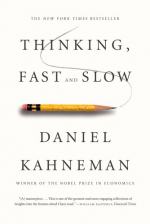
|
| Name: _________________________ | Period: ___________________ |
This test consists of 5 multiple choice questions, 5 short answer questions, and 10 short essay questions.
Multiple Choice Questions
1. Who created the Cognitive Reflection Test that involves the bat-and-ball problem along with two others?
(a) Shane Frederick.
(b) Daniel Gilbert.
(c) Danny Oppenheimer.
(d) Larry Jacoby.
2. What are the subjects in the gorilla study instructed to count in the short film?
(a) Seconds while a woman runs.
(b) Scores on a video game.
(c) Baseball throws.
(d) Basketball passes.
3. Who introduced the word "flow" to describe the state of effortless attending?
(a) Nassim Taleb.
(b) William Feller.
(c) Mihaly Csikszentmihalyi.
(d) Larry Jacoby.
4. Based on the law of least effort, the author concludes that what characteristic is built deep into our nature?
(a) Laziness.
(b) Heroism.
(c) Gratitude.
(d) Bitterness.
5. What word from Chapter 6 refers to the state of being out of keeping with the norm or inconsistent?
(a) Recognition.
(b) Articluation.
(c) Depletion.
(d) Incongruity.
Short Answer Questions
1. Cognitive strain is defined by the author as being affected by both the current level of effort and what?
2. When did the Yom Kippur War break out?
3. What is System 2 in charge of in terms of behavior?
4. What is a reliable way to make people believe in falsehoods?
5. The author notes that stereotyping is a negative word in our society. How does the author apply the word in his usage?
Short Essay Questions
1. What was involved in the Invisible Gorilla experiment? What did it demonstrate?
2. How does the author explore talent and luck in the book?
3. What is Bayesian inference?
4. What is a heuristic?
5. How does the author correlate text font to illusion?
6. How does System 1 operate?
7. What does WYSIATI mean and how does the author apply it?
8. What are the results of our predilection for causal thinking?
9. Describe the Muller-Lyer illusion. What does it demonstrate?
10. Who was Amos Tversky and what were his accomplishments?
|
This section contains 692 words (approx. 3 pages at 300 words per page) |

|




